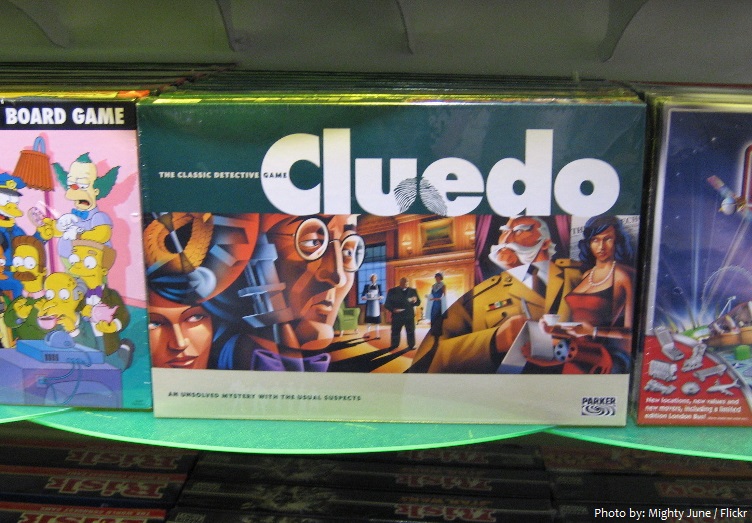
Cluedo known as Clue in North America, is a murder mystery game for three to six players (depending on editions) that was devised in 1943 by British board game designer Anthony E. Pratt.
The object of the game is to determine who murdered the game’s victim, where the crime took place, and which weapon was used. Each player assumes the role of one of the six suspects and attempts to deduce the correct answer by strategically moving around a game board representing the rooms of a mansion and collecting clues about the circumstances of the murder from the other players.
In the 1930s and early 1940s, a British musician named Anthony Pratt played gigs at country mansions. The elegant guests would often play act at these get-togethers, and it was typically crimes involving “skulking, shrieking, and falling dead to the floor.” Pratt took mental notes of these games while he played piano.

Holed up in his home in Birmingham, England during air raids on the city during World War II, Anthony E. Pratt, recalled the murder mystery games played by some of his clients at private music gigs as well as the detective fiction popular at the time, most notably Agatha Christie.
In 1944, Pratt applied for a patent of his invention of a murder/mystery-themed game, originally named Murder! Shortly thereafter, Pratt and his wife, Elva Pratt, who had helped design the game, presented it to Waddingtons’ executive Norman Watson, who immediately purchased it and provided its trademark name of Cluedo (a play on “clue” and Ludo, ludo being Latin for “I play”).
Pratt’s original patent included 10 characters and 11 rooms. It also included more weapons in addition to the revolver, dagger, rope, lead pipe, candlestick, wrench: there was also a shillelagh, a hypodermic syringe, an unused bomb, fireplace poker, an axe, and poison. (Jeez, man take it easy.)

In 1947, Pratt patented the game and sold it to a U.K.-based game manufacturer named Waddington’s and its American counterpart, Parker Brothers (now owned by Hasbro). But because of post-war shortages the game was not released until 1949—as Cluedo in England and Clue in the United States. In both versions, the object is for players to collect clues to figure out the murder suspect, weapon and location. The game took place in a Victorian mansion. The victim’s name? Mr. Boddy.
Cluedo was originally marketed as “The Great New Detective Game” upon its launch in 1949 in North America. A deal was quickly struck to license “The Great New Sherlock Holmes Game” from the Sir Arthur Conan Doyle estate. Advertising at the time suggested players would take on the guise of “Sherlock Holmes following the path of the criminal”, but no depictions of Holmes appear in the advertising or on the box. From 1950 until the 1960s, the game was marketed as “The Great Detective Game,” at which time it became the “Parker Brothers Detective Game”.

With the launch of the US 1972 edition, a television commercial showed Holmes and Watson engaged in a particularly competitive game. Adjusting with the times, in 1979 US television commercials a detective, resembling a bumbling Inspector Clouseau from the popular Pink Panther film franchise, looks for clues.
The comedy whodunnit Clue (USA, 1985) was based on the boardgame Cluedo. It starred Tim Curry (UK) as the butler, Wadsworth, aiming to finger the killer of his employer, Mr Boddy. The six suspects are all characters from the game: Mrs Peacock (Eileen Brennan, USA), Mrs White (Madeline Kahn, USA), Professor Plum (Christopher Lloyd, USA), Mr Green (Michael McKean, USA), Colonel Mustard (Martin Mull, USA) and Miss Scarlet (Lesley Ann Warren, USA). Three different endings were filmed, and a different one shown at different theatres.
In 1993, Peter DePietro and Tom Chiodo of the Manhattan Rep Company promoted a Clue world championship event in New York City. Part competition and part performance art, contestants played while interacting with actors dressed as Clue characters. Clues were doled out in dialogue and via music. The winner was Josef Kollar from the UK, who also came dressed as Colonel Mustard. Kollar won a trip to Hollywood.

In the UK, Cluedo was marketed as “The Great Detective Game” from the mid-1950s until 2000, when it was rebranded as the “Classic Detective Game.”
One of the most significant changes to Clue in the last 70 years, says Ricketts, came with the introduction of a rare new character. In 2016, Hasbro’s Clue killed off the housekeeper Mrs. White, replacing her with the more accomplished Dr. Orchid, the adopted daughter of the mansion’s owner. Dr. Orchid has a fancier career — she’s a working scientist with a Ph.D. — but she comes with a sinister background, having been expelled from her Swiss boarding school after a (dun dun dun!) near-fatal daffodil-poisoning incident.